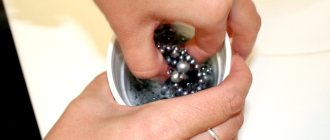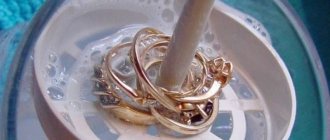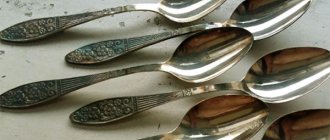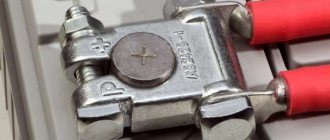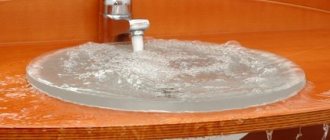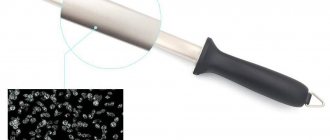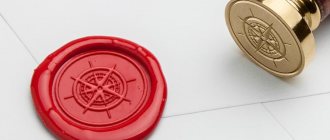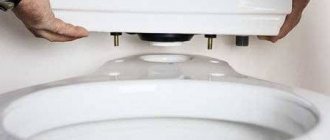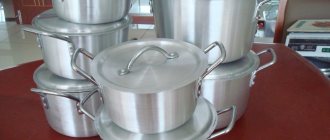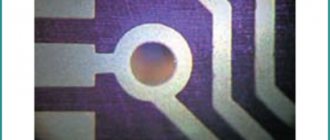Reasons for the raid
Dishes, furniture fittings, jewelry and other things made of copper need periodic cleaning to remove green deposits. This need is associated with the characteristics of the metal. Due to prolonged exposure to air or exposure to temperature, such things become covered with a dark greenish film. Oxides are especially noticeable on dishes that are constantly used in the kitchen. Darkening can only be removed by cleaning.
Jewelry with copper behaves differently. They sometimes darken, but then return to their original state. It is widely believed that this behavior of the metal is a reflection of the health of the owner of the jewelry. In reality, such changes only reflect a reaction to environmental indicators: fluctuations in humidity, pressure or temperature.
Oxides on copper cookware are especially dangerous. If plates and pots are not cleaned for a long time, the metal releases toxic substances that are harmful to human health.
Metal oxidation
Copper in its usual state has a reddish tint. If a metal is exposed to air for a long time, it acquires a red-violet or blackish tint due to a layer of oxides forming on its surface. Prolonged exposure to high humidity conditions provokes the formation of a layer of hydroxides on a copper product. Then a greenish color appears. An acetic acid layer of blue-green color also appears on the copper from contact with vinegar. It is a poisonous substance.
Raid
Before you start cleaning, you need to determine whether the item is actually made of copper. The easiest way to do this is to use a magnet. Copper makes little contact with the magnet, but even the resulting attraction quickly disintegrates. Therefore, if a magnet sticks firmly to the surface of a thing, it is definitely made of another metal.
Then they determine whether there is plaque on the object or whether the peculiar layer is just a coating of varnish. Then a small amount of baking soda is quenched with vinegar and the resulting liquid is dripped onto the surface of the item. If a liquid quickly brightens an object, then the darkened layer is oxides that need to be gotten rid of.
Causes of oxidation
Cold welding for metal
Having understood the types of lubricants, you should find out why the battery terminals oxidize. In fact, there are a number of reasons, here are the main ones:
- Poor contact between the end of the wire and the battery itself. During operation, a gap has appeared into which vapors from the electrolyte enter. The damage just needs to be sealed.
- The terminal cover is scratched or worn off. Replacement required.
- The battery terminal is not sealed. The electrolyte leaks out and the surface of the contact assembly is corroded.
- The generator is recharged. In this case, you should go to specialists.
If the battery terminals are constantly oxidizing, what should you do? It was said above how to behave in the case of the above reasons. But what to do when the oxidation became so strong that the car stopped starting. In this case, it is necessary to clean the terminals
To do this, take sandpaper and carefully rub off the plaque. Be extremely careful not to damage the insulating sheath
Perform work with gloves. For better contact, use one of the lubricants discussed above.
When the positive terminal oxidizes, this can happen for the following reasons:
- The battery seal is broken somewhere. It is necessary to intervene in the situation urgently, because over time the acid can eat through the body without any problems.
- The battery was systematically recharged, which led to overheating of the electrolyte and, as a result, it began to evaporate too actively. In this situation, there is nothing left but to go to the car market or auto store to buy a new device.
What to lubricate with? At the beginning of the article, the most popular lubricants of both old and new types were given. You only need to add liqui moly battery terminal lubricant. Among its features, it is worth noting the reliable protection of contacts from corrosion. The motor will work in any weather conditions. The most important thing is that the battery life is increased by almost two and a half times. This lubricant prevents current leakage. Before applying it, you should thoroughly clean the required area. Again, use a knife or sandpaper, as described earlier.
Cleaning copper products at home
Copper products that are constantly used should be cleaned regularly. A simple rinse under the tap in dishwashing detergent is suitable. Instead, you can wipe down copper items with sanitary gel. If these methods do not bring cleanliness and a significant part of the product remains covered with plaque, more aggressive cleaning methods are used.
Vinegar with salt
In this case, rub the item with a soft cloth using a special product. It is mixed from 1 cup of ordinary vinegar and 1 tbsp. l. salt. After cleaning objects from oxide, they are washed with clean water and wiped thoroughly.
Another method for cleaning copper at home is to boil the item in a solution of salt and vinegar. For it, add 1 glass of ordinary vinegar and 1 tbsp to 3 glasses of water. l. table salt. The copper product is placed in the prepared solution and left to heat up. After 15 minutes of boiling, it is possible to remove all the green deposits. Then the item is taken out and washed under running water with detergent.
This cleaning method is used for copper items with or without a protective coating.
Cleaning with ketchup
This is an easy and affordable method to clean copper products from plaque. In this case, cover the surface of the copper item with the sauce and set aside for 30 minutes. Then polish the surface with a soft cloth, and wash off the remaining ketchup with warm water. This method returns the lost shine to the item. In the same way, you can clean copper utensils from patina using kefir.
Cleaning with salt and lemon
In this way, you can clean a copper basin at home or large copper products until they shine, for example, samovars and pots. Cut the lemon into two parts and sprinkle the cut area with coarse table salt. Then polish the surface of the kitchen utensils.
You can make a special paste for cleaning copper. For it, mix table salt, baking soda and flour in equal volumes, then add lemon juice to form a paste-like mass. This product is used to rub the surface layer of the object until it shines. After cleaning, the item is washed with heated water. As a result, the copper product acquires a mirror shine.
Using Baking Soda
It is convenient to use baking soda to clean copper at home in combination with lemon juice. Use the resulting liquid to wipe the surface layer of the item with a soft cloth and then rinse. Instead of lemon juice, you can clean copper with citric acid dissolved in water and soda.
Another way to use baking soda to clean copper from oxides is by boiling:
- Dilute 1 tbsp in 1 liter of water. l. soda and lower the product completely into the liquid.
- The container is set to heat up and boil for half an hour, after which the heating should be turned off.
- Then the product is washed with heated water and wiped completely.
Using the proposed method, green deposits are removed from a copper product. It is also used to remove damaged varnish on copper items.
Vegetable oil
An excellent means for cleaning copper is vegetable oil. It's even better to use olive oil. This method is good because it is natural, environmentally friendly and harmless. Therefore, it is especially recommended to use it when you need to clean valuable items from oxidation.
To do this, olive oil is poured into a deep container and copper objects are placed in it. After 10 days, they are removed and cleaned with a soft brush or cloth. Then they return to their place. Such actions are repeated every 10 days for two months.
How to clean contacts from oxidation in a car
Silicone grease is a good option, as it does not absorb dirt like other materials.
Special lubricant (anti-grease). You can get it at an auto store. The mixture has anti-corrosion properties; it is an aerosol that is used to spray the terminals.
How to lubricate battery terminals to prevent oxidation Lubricated positive terminal
Selecting a lubricant for battery terminals
If you don’t know how to lubricate the battery terminals to prevent oxidation, then use the following tips. Since battery restoration costs a lot of money, you should approach the choice of means seriously. Opinions always differ on the choice of lubricant for terminals. Some remain adherents of old-fashioned methods, while others prefer new technical developments. In this regard, it is worth analyzing the arguments for and against.
Solid oil remains the most popular lubricant. After cleaning and tightening the terminals, apply a thin layer of it, this will help you forget about the problem for almost six months, provided that everything is sealed and the battery is not damaged. Its downside is that over time it begins to coke, that is, roll into lumps, which cannot be said about Vaseline. The next equally popular remedy is Vaseline; you can use both pharmaceutical and technical. Although it perfectly protects batteries from moisture and soldering, it has poor conductivity. To fix this, you need to mix Vaseline with graphite lubricant.
Litol can be attributed to the old means of protection. Only it is inferior to all modern means of protection in terms of effectiveness, since it can be washed off with shampoo. It has a loose, loose structure, where there are no additives or additives, no dyes. Until now, many manufacturers have not renounced this type of lubricant, and recommend them in battery instructions.
What to do if the battery terminals oxidize Contact cleaner
But what about the fact that for some battery models it is impossible to make fiber mats impregnated with oil? Probably the best way out of the situation would be to create general protection - like an anther. For example, you can use linoleum or a “classic” rug. Even if from the outside it does not look aesthetically pleasing, it will at least somehow protect the battery from the penetration of dust and dirt.
GAZ Club - AllGAZ.ru > Tips (FAQ) > Our garage > Electrics > How to clean soured contacts on the ECU?
View full version : How to clean soured contacts on the ECU?
Guys, what is the best way to clean the contacts on the ECU? Some small wires are coated with white oxide. What to buy, what to spread, spray, wash off?
I opened the body of the scale and was horrified to see that almost all the contacts were covered with a white coating due to the fact that the alkaline batteries had leaked or oxidized. I remember this happened to my car once, then they advised me to clean it with soda, but then it was a completely different battery.
Please tell me how to properly clean oxidized contacts?
I'm afraid this task is difficult to accomplish. Especially if they already look like the one in the picture. You can try, after drying, wipe with a hard cloth and rinse with alcohol. Can be cleaned manually with a screwdriver. You can clean it with zero sandpaper, which is undesirable (they will oxidize quickly).
I wouldn’t bother with the battery shown in the author’s photo and fiddle with it if there is an opportunity to buy a new one, but often at the most inopportune moment, when there is no way to buy it, especially when you are far from civilizations, it happens such an unpleasant incident, and here, like it or not, you have to fiddle around, restore and revive it.
The main way to clean it from oxidation is alcohol or ammonia solution.
Another option, when I myself cleaned the contacts from oxidation, is hot water and baking soda proportion: a quarter of soda per liter of water and dip and rinse the oxidized part into such a solution (remember that in this case foam will form as in the boiling process, so be careful and work with gloves, and hold the contacts in long tongs or pliers) after which the contacts will shine, dry them, and then go to work.
Use of chemicals
Sulfuric acid removes darkening and green deposits from the surface layer of copper very well. It is mixed in equal proportions with water and a copper bracelet or other objects are placed in the liquid. When the seething begins, take the item out and wipe it well with a soft cloth. Then the item is laid out on a flat surface to dry. This cleaning method returns the product to its original shine.
When working with sulfuric acid and other aggressive substances, put rubber gloves on your hands, and protect your respiratory organs with a respirator.
Another cleaning method is to use the drug Trilon-B. The substance is stirred in water in a ratio of 1:10. Afterwards, the copper product is lowered into the resulting liquid and observed. When the required degree of cleanliness is achieved, the item is taken out and washed with clean water.
Abro EU-533
This product is used to process automotive, computer, household, audio and video equipment, namely electrical contacts and electronic board elements. Abro EC-533 can be considered a universal cleaner as it is used to remove dirt, grease, oil, corrosive deposits and oxides.
You need to wear special protective gloves when working with this cleaner. The price of an aerosol can (163 ml) is 300 rubles.
Cleaning Copper Coins
Coins made of copper and its alloys are often found in the collections of numismatists. Over time, their appearance deteriorates. A yellow film appears on coins if lead is included in the alloy. You can get rid of such a substance by immersing objects in a vessel with a solution of laundry soap. After 2-3 hours, the coins are taken out and wiped with a rag soaked in table vinegar. After such cleaning they become shiny.
Read also: Drill machine for wood
You can remove blackness from copper using citric acid:
- Mix a solution of 200 ml of water and 2 tsp. citric acid.
- Soak a piece of cotton wool with the product and wipe the parts of the coin.
- After cleaning, the products are rinsed well.
Reddish deposits from coins, crosses and bracelets made of copper are removed by treating with ammonia. Things are dipped in ammonia for half an hour, and then washed in heated water.
Removing black and green plaque
To degrease the surface and remove the patina, use a mixture of turpentine, oxalic acid and ethanol. A solution is prepared from these equal volumes of funds. A rag is moistened in it and the products are wiped. Another cleaning method is to use crushed chalk and kerosene. The substances are combined to form a thick mass and used to polish objects.
When the layer is insignificant, it can be easily removed with ordinary soap. It is dissolved in water and the entire thing is dipped into the soapy solution. Then polish with a thick sponge.
A greenish and black layer on copper utensils indicates its unsuitability for cooking and preserving food. Such products must be cleaned before use.
Cleaning rust
In addition to plaque of various shades, rust appears in the top layer of copper objects, which is iron oxides in the form of flakes. To remove it, use strong acidic solutions, and to wash products, use a baking soda solution.
An acid solution is poured into a cup made of ceramic, glass or other inert material and the copper product is immersed in it with tweezers. A reaction will begin, during which rust is removed and dark smoke comes out. When the process is complete, the product is carefully removed and placed in a baking soda solution to neutralize the acid. The washed item is thoroughly wiped with a rag.
When handling acid, be sure to protect your hands with rubber gloves, wear a protective mask or goggles and a respirator.
Cleaning a Turk, samovar or kettle
The exterior of this kitchen utensil can be cleaned using any of the suggested methods. The inside is much more difficult to clean. There, objects are oxidized by water, but also covered with a lime layer.
To remove dirt from the inside, potato peelings are used. They are placed in a bowl and poured over with boiling water. Then set the utensils on the fire and boil the cleaning for an hour. Then the contents are poured out, and the utensils themselves are washed in heated water with detergent.
To complete the cleansing, boil plain water several times in a cleaned container. This gets rid of traces of limescale.
How to clean and protect contacts?
All contacts sooner or later begin to corrode and become covered with nasty oxides, disrupting the operation of the system.
Therefore, the logical question arises - what and how to clean the contacts?
It is highly undesirable to clean contacts mechanically. And in modern systems you can’t really get close to them. Traditional methods with an eraser, soda and the like do not give the desired result. And I consider the use of these ancient methods in the 21st century to be a fight against windmills.
As a radio mechanic, I have long been using modern chemistry to solve these problems. The same chemistry successfully broke into the automotive industry.
From practice, in my opinion, two such means deserve special attention.
Useful tips
To ensure that copper items last longer, they should not be cleaned with abrasives or rubbed with metal brushes. Copper is a fairly soft metal and is easily scratched by hard objects.
It is better to store copper utensils, jewelry, embossing and coins in a special cabinet. It must be dry and ventilated. In such conditions, things made of copper retain their attractive appearance. If objects are kept in constant humidity under conditions of a significant increase in temperature, they quickly lose their attractiveness and become covered with patina.
You cannot cook food containing foods with a high acid content in copper cookware. This renders kitchen utensils unusable. When cookware has a decorative coating, it should not be polished or cleaned with abrasive materials. Such items can only be washed in heated water using a soap solution. Periodically wipe all copper utensils with a clean, soft cloth to prevent dust and soot from settling on them.
Stage 1: disassemble the device
In our case, to disassemble the acid-soaked keyboard, you will need a screwdriver. Your device may be a little more complex. Be that as it may, it is necessary to understand how it is understood.
As you can see, not too much acid was spilled; there is hope that it will be possible to revive the gadget.
Oxidation occurs rather slowly, but from the very beginning of this process, a leaking element can damage electronic devices with conductive liquid. Considering the fact that batteries can be used in expensive devices, for example:
- Computer BIOS;
- cameras;
- joysticks for xbox.
It is necessary to establish the fact of a failing battery as early as possible. You should also study the main causes of battery leakage and the formation of deposits on the contacts in order to try to prevent such problems during operation of the device.
Oxidation always occurs more intensely at high humidity, so if you need to operate the device in such conditions, you should change batteries more often, especially the salt type.
Battery oxidation is most often observed in the following devices:
- Remote control.
- Alarm key fobs.
- Children's toys.
- Computer keyboard and mouse.
- Photographic flashes.
- Flashlights.
- Hours.
Similar problems can also be observed in the battery socket of geysers if the element has not been changed for a long time.
Electrolyte leaked onto the remote control housing
Basic rules for caring for copper products
- Copper dishes love cleanliness. Therefore, after each use it must be thoroughly washed and wiped dry.
- Copper should not be cleaned with aggressive substances or brushes. When caring for metal, avoid using products containing abrasive particles and chlorine.
- To avoid scratching the dishes, give preference to wooden, plastic, silicone spoons and spatulas.
- Copper jewelry should be cleaned regularly, especially after wear. A damp cloth will wipe away dust and traces of sweat. Afterwards, wipe dry with a soft cloth.
- Air, sunlight and the proximity of heating devices negatively affect the appearance of copper jewelry. Therefore, it is recommended to store them in a box, wrapping each individually in soft fabric (for example, flannel).
- If you coat copper with metal varnish, the jewelry will retain its attractive appearance for a long time. You just need to update the coating from time to time.
Why do copper products need to be cleaned regularly?
When air and moisture come into contact, a film forms on the surface of the copper. It must be cleaned, because this coating not only spoils the appearance of the product, but can also be unsafe for humans.
Plaque on metal forms for two reasons.
Metal oxidation
When oxygen and copper interact, a chemical reaction occurs that causes the metal to oxidize. At the first stage of oxidation, copper changes its color to purple with a reddish tint. If the deposit is not cleaned off, the oxide will subsequently turn black.
Plaque on a copper product
When copper is left in a humid environment for a long time, a dense green coating forms on the metal - this is the so-called hydroxyl film. Copper hydroxide is poisonous. You cannot eat from dishes that have such a coating. You need to take precautions and remove the film.
Also, copper products may develop a white coating or rust.
How to clean oxidized contacts?
How to clean oxidized contacts?
Post by KZ » 03 Jan 2012, 08:47
The batteries are leaking, the contacts have oxidized. What to do?
How will VKSI help us?
oxidized contacts can be wiped off with hydrogen peroxide; if there is any rust, WD 40 is good with lemon juice; if you have nothing else on hand, contact spray (in aerosol cans). Look at auto parts stores. Very effective + no need to squirm, think about how best to get to the contacts. If the oxide is not strong, then an eraser on a pencil can help. As an option, it’s also plus a powder cleaner like pemolux or cif (cream, but also cleans). Try first washing the dried electrolyte with soda/vinegar and wiping with artificial suede. If you mechanically peel off the coating on the contacts, they will simply be oxidized by the moisture in the air, and you will end up not with a flashlight, but with something else. Of course, a match polisher or zero emery will proudly bury the contacts once and for all; it is not recommended to even clean iron battery contacts with them, since they will lose complete and unconditional PI! Yes, and the contacts are coated with low-quality gold and they will oxidize even more if they remain :) For such purposes, it is better to use felt cloth pre-smeared with PASTAGOGY, for replacement you can use a piece of denim rag sprinkled with comet (naturally in dry form), and dirt can rinse with cotton swabs soaked in ALCOHOL. Secret: contacts for soldering can be tinned in an aspirin tablet (Acitylsolicylic acid) instead of flux, it removes metal oxide well, if only it weren’t for the smell during this process, there would be no need for flux :) try a cotton swab with alcohol, I also had leaks, that’s all processed, restored.
Effective Copper Cleaning Methods
Before using various methods to clean copper, wash the product in warm soapy water or dishwashing liquid. This will help remove minor dirt, dust and add shine. If after the procedure the surface remains unchanged, proceed to cleaning using one of the methods convenient for you.
Copper cookware should not be washed in the dishwasher. It is preferable to wash and clean by hand.
Vinegar with salt
They cope well with thick layers of plaque. To clean, pour 9% vinegar over the plaque and sprinkle with finely ground salt. After 10 minutes, wipe with a cloth and rinse.
Cleaning copper with ammonia
Soak a rag in ammonia and apply it to the copper product. Then wipe with a clean rag to remove the ammonia. For a better effect, chalk chips are added to the alcohol. It mechanically scrubs and absorbs dirt.
Cleaning copper with phosphoric acid
To clean copper from rust, phosphoric acid is used. The product is dipped in a 15–30% solution of orthophosphoric acid and applied with a brush or spray. Leave for a few minutes to take effect. Clean off plaque with a cotton cloth. If necessary, repeat the procedure.
Cleaning with ketchup
This unexpected solution has proven itself in cleaning copper products from black deposits. Apply a generous amount of ketchup or tomato paste to the metal. Leave for an hour and wipe with a cotton rag. The fruit acids contained in tomatoes will not only get rid of plaque, but also restore the brightness of the metal.
Cleaning with salt and lemon
Squeeze the juice of one lemon. Add salt until a paste forms. Using a cloth or toothbrush, clean the surface of the copper to remove any dirt.
Using Baking Soda
Baking soda is one of the popular substances for cleaning metal objects. When cleaning with baking soda, copper products regain their lost shine.
Vegetable oil
Vegetable oil fills microscopic cracks in metal. Thanks to this, the product looks smoother, gaining a natural shine.
Use of chemicals
In addition to regular household cleaning products for cleaning copper, you can purchase specialized preparations at a jewelry store. They are good because they carefully clean the metal without damaging it. Such drugs include Trilon B.
Which car contact cleaner (spray) can be used (review of options)
Now there are many special products on sale for cleaning oxidized contacts.
Contact cleaner KONTAKT 60
Oil-based cleaner Contact 60 is designed to clean contacts from non-conducting films, preventing problems with electrical connections in connectors and other electrical connections.
Basic properties:
- rapid evaporation;
- reliable removal of oxide, sulfate, sulfide, carbonate films;
- dissolution of oil and resinous contaminants;
- restoration of low-current connections (for example, via a linear audio output cable of a radio);
- the presence of a 360-degree valve for operation in any geometric position.
Liqui Moly Kontaktreiniger cleaner
Properties:
- restores electrical connections;
- removes metal oxides formed on the surface of conductors,
- prevents leakage currents;
- reduces contact resistance;
- helps reduce heating of the contact area;
- does not contain silicone.
Recommendation for use:
- turn off the ignition;
- remove the battery terminal;
- apply the product to the cleaning area;
- leave for 10 minutes for the reagents to act;
- remove the accumulated deposits from the cleaning area using Elektronik-Spray (art. 3110) or LM 40 Multi-Funktions-Spray (art. 3390).
Contact cleaner Abro EC-533
A special feature of this product is that it can be used in car control units, computer equipment, and radio devices.
Hi-Gear HG40
This product belongs to the group of multifunctional penetrating lubricants. Its composition helps displace moisture and cleanse the application site. However, this tool is not specifically designed to fix electrical connection problems. It can be used to perform the functions of a regular Vadeshka.
Car contact cleaning spray WD-40 Specialist
This product is designed specifically for use in contact areas. Along with standard products for these functions, WD-40 Specialist cleans rubber and plastic materials and can be used on various classes of electronic equipment in automobiles, household appliances and computer equipment. The operating temperature range is from minus 20 to plus 90 degrees Celsius. The product has 4 varieties:
- penetrating lubricant for working with metal surfaces;
- quick-drying contact cleaner;
- white lithium grease for application to moving metal joints;
- A quick-drying silicone lubricant that helps prevent the formation of rust and other oxides.
Mannol Contact Cleaner 9893
Features of this product:
- increases the electrical conductivity of the contact zone;
- works effectively on battery terminals;
- has increased performance.
How to clean copper products until they shine?
The choice of cleaning method depends on the degree of contamination and the type of product that needs to be treated.
Read also: How does a lubricator for pneumatic tools work?
Cleaning copper from white deposits
White spots on copper are also formed due to oxidative reactions. They usually appear on products made from alloys of copper and other metals. One of the presented methods will help against this kind of contamination: using ammonia, vinegar with salt or ketchup.
How to clean copper from black and green deposits?
Ammonia can deal with black and green deposits. You can also remove the toxic layer with a mixture of turpentine, oxalic acid and vodka. The ingredients are mixed in equal proportions and the copper products are cleaned with it using a cloth.
Cleaning copper from rust
To renew rusty copper products, use aggressive acids such as hydrochloric acid. Apply acid to a piece of cloth and treat the copper with it. After treatment, rinse thoroughly to remove any remaining aggressive substance.
When working with acids, be sure to wear gloves. And clean only in a well-ventilated area.
How to clean copper oxide?
To remove oxide in the form of a reddish coating, place the product in a 5% ammonia solution or ammonium carbonate. Hold until the plaque begins to come off.
How to clean a copper pot inside and outside?
The outer surface of the Turk can be cleaned using any of the methods presented above.
If you do not have experience working with aggressive chemicals and acids, use accessible and safe methods.
On the inside of the Turks, it is recommended to use softer substances so as not to damage the coating. For example, soda or ketchup.
Mechanical cleaning of copper products
Over time, a layer of dirt adheres to jewelry and various objects with carved patterns, consisting of many parts. You can get rid of it mechanically.
Start by removing surface dirt by washing the jewelry with soapy water. Next, use a needle to remove dirt from small holes and crevices. Then go over the entire product with a toothbrush.
During mechanical cleaning, you can use salt or baking soda, so the effect will be achieved faster.
How to clean tinned copper?
During the tinning process, a thin layer of tin is applied to the inside of copper cookware. Tin is a soft metal and must be cleaned with care.
Do not use sharp objects or harsh abrasives.
To clean a tinned copper product, you need to wash it with dishwashing detergent. Severe dirt is removed point by point with a soft brush or fine steel wool, previously soaked in vegetable oil.
How to clean a copper samovar?
The copper samovar is an antique item. Therefore, it is especially important to preserve its appearance and extend the service life of an antique device.
To clean a copper samovar, take salt, vinegar and flour in equal proportions. The ingredients are mixed and applied with a sponge to the outside of the samovar.
After treating the entire surface, remove any remaining cleaning agent with a dry cotton cloth. To make the surface shiny, wipe it with lemon.
If there are deep stains in the samovar, they can be removed with kerosene. Soak a cloth in the mixture and wipe particularly dirty areas.
How can you clean a brass samovar?
Brass is an alloy of copper and zinc. Aggressive chemicals and abrasives can damage the surface of such a samovar.
For safe cleaning, use oxalic acid. It must be diluted in 1 liter of water, applied to the surface of the samovar and left for 5 minutes for the reaction to occur.
Afterwards, the solution is washed off and the surface is wiped with a sponge soaked in soda solution to neutralize the acid. Rinse the product and wipe dry.
Clean a copper basin at home
As a rule, a copper basin is used to make jam. Such dishes have good thermal conductivity, antiseptic properties, are safe for humans, and when cooking the jam practically does not stick to the walls.
If the jam is still burnt, the copper basin can be cleaned with vinegar dough. For this ancient method, you need to knead the dough by mixing flour and table vinegar. Next, the dough is rolled out thinly and placed on the dirt.
After the mixture dries, carefully remove it. The vinegar paste absorbs dirt, making the surface perfectly clean.
How to clean the charging contacts on your phone?
A dirty USB connector can lead to problems with charging, as well as with connecting to a computer. There are four easy ways to clean it:
- Piece of paper.
- Needle.
- Brush.
- Alcohol.
- Compressed air.
In principle, they can be used sequentially.
First stage. Plain paper. Tear off a piece from an A4 sheet, fold it in half or in four to form a pointed corner. Insert it into the connector, carefully cleaning out any dirt. This is a method for field conditions when there is nowhere to get a needle and brush.
Second phase. Thin needle. A regular sewing needle or a needle from a medical syringe will do. Simply blow off the removed dirt onto the table.
Third stage. Fine cleaning with a brush. Its pile should penetrate into the nest, reaching the most secluded corners. Use a cosmetic or old toothbrush with medium hardness. Place the lint inside the connector and clean it. No hard brushes or sudden movements - spare your smartphone and your own money.
Fourth stage. Cleaning with alcohol or alcohol-containing liquid. Take the phone vertically and pour liquid with a pipette or syringe into the connector in a stream from bottom to top. The excess will drain. Dry with a hairdryer on low power. Once dry, test by connecting the cable to the charger.
Fifth stage. A compressed air cylinder for contactless cleaning of dust from electronics. “Blow” the can into the connector several times and the dirt will fly out.
The order of the steps can be changed at your discretion. And a few caveats:
- Avoid applying pressure to avoid damaging the connector.
- Do not use aggressive liquids instead of alcohol, which may react with plastic.
- Do not use hard brushes, thick needles, paper clips or toothpicks.
To protect the connector, you can buy plugs on Aliexpress. They will prevent clogging. Cost - within 80-100 rubles.
Dust plug for headphones and USB phone
For cleaning, I recommend using antistatic ESD brushes.
Antistatic brushes for electronics
Cleaning Copper Coins
Antique copper coins often have high antique value. Therefore, it is important for every numismatist to know how to clean a coin without damaging it.
Boiling coins in soda solution
Baking soda not only perfectly cleans copper coins, but also makes them shine.
To begin, dissolve 10 tbsp in a saucepan. spoons of soda in 1 liter of water. Dip copper coins into the solution until they are completely covered with liquid. Place the pan on the fire and simmer for 30 minutes.
Let the coins cool and remove any remaining baking soda using a toothbrush.
"Trilon B"
This special chemical mixture can be purchased at jewelry stores. It does not destroy the surface of copper products and carefully cleans them of oxide.
Dip the products into the solution and hold for 10–20 minutes. In case of severe contamination, the procedure can be repeated.
Kefir and vegetable oil
Kefir contains non-aggressive acids that gently cleanse copper. Place coins in fermented milk product for 1 hour. Then rinse with running water and dry.
Vegetable oil also gently cleans coins, filling small cracks and giving them a natural shine. Pour 2 cm of oil into a pan and boil. Using tweezers, lower the coins and boil them for 10-20 minutes. Then rinse the items with dishwashing liquid and dry.
Citric acid and vinegar
Vinegar will help remove dark spots on old coins. Dilute 1.5 tbsp in 500 ml of water. spoons of vinegar (9%) and salt. Dip coins into the liquid and put on fire. Boil for 10 minutes, rinse and dry.
On a note. Instead of vinegar, you can use citric acid or freshly squeezed lemon juice.
How to remove oxide from contacts?
Repeat until the spill is completely cleaned up, then let the device dry for a few hours.
Clean up the lithium leak with water.
Packets of lithium batteries, which are often used in cell phones or button batteries, should be placed immediately in a sealed, durable container as they may cause a fire or explosion. Any electrical devices affected by the spill are no longer safe to use. Throw away the device and clean up the spill with water and nothing else.
- Some battery manufacturers may offer you a new battery for free or at a reduced price.
Clean electrical contacts (optional).
If the battery was powering a device at the time of the leak, you may need to clean the electrical contacts on that device before you can safely use it again. Use a plastic or wooden skewer to scrape up any spills, then wipe the contacts with a slightly damp paper towel, then pat dry with the towel. If the contacts are rusted, acid-corroded, or discolored, sand them down with sandpaper or a file, but be aware that they may need replacing.
What could be the reasons for contact oxidation:
- Electrolyte leak. The most common case. Being an acid, the electrolyte causes a reaction when it comes into contact with the contacts, resulting in oxidation. Since the battery vibrates all the time, a gap forms between the contacts, and it is through this that the acid gets onto the surface of the terminal. For modern batteries, this kind of problem is not relevant, because such batteries are closed and the electrolyte is placed in a sealed container, where it evaporates and precipitates. But there are cases when the battery is damaged in one way or another during operation and through microscopic cracks the electrolyte escapes in the form of steam and settles on the terminals, thereby provoking a chemical reaction. Please note: electrolyte can sometimes leak when the battery charge is high and there are problems in the electrical circuit. Leakage is also possible if the standard ventilation holes are clogged.
- Electrolyte with unacceptable density values. To avoid such situations, it is necessary to use a ready-made composition when replacing it, and not independently measure the components to the required proportions.
- The battery life is exhausted - a situation in which the seal rods have dried out.
- Terminal tightening. This happens when the driver puts the terminal on the electrode without securing it with bolts and starts driving the car. A weak fastening results in weak contact, hence the reaction. The way out is to clean the terminal and electrode plus tighten it tightly.
Experienced car enthusiasts have encountered this problem more than once, so they can easily explain why the positive or negative terminal is oxidized.
By several signs you can easily determine whether there is damage:
- If you turn the key, but the starter does not engage after several attempts or turns the crankshaft with difficulty. There is an assumption that the battery does not have enough charge, although it was charged not so long ago.
- Side lights and headlights do not shine brightly.
How not to clean copper products
In order to preserve the shine of copper products for a long time and not scratch their surface during cleaning, you must not:
- use abrasive materials and hard metal objects;
- subject to constant exposure to humidity;
- remove the varnish layer, if there is one on the product;
- expose to direct sunlight and heating devices;
- leave copper objects dusty, without carrying out wet cleaning for a long time.
To maintain the attractive appearance of copper products, they need to be cleaned regularly. It is important to remember that over time, copper wears off and objects become thinner. Therefore, do not wait until the dishes and decorations are covered with a thick layer of dirt. After all, small stains are easier to clean using more gentle methods.
Copper has long been used to make dishes, jewelry and many other household items. In this article we will talk about how to clean copper and how to properly care for copper products.
If improperly or irregularly cared for, items made from this metal may lose their shine, oxidize, darken, or become covered with a green coating. We'll tell you how to avoid these troubles.
Prevention of contact oxidation
In addition to the indicated homemade washers, which prevent the appearance of oxides on the terminals, you can use modern, specially developed compounds. As practice shows, they are much more effective than old handmade ones. Typically, such compounds have bright colors to distinguish treated surfaces from untreated ones. Their application promotes the formation of a protective film and, as a result, protects against the appearance of oxides.
The conclusion is simple. It is better to open the hood more often, not be afraid to inspect the battery and other contacts and take preventive measures in the form of cleaning them and applying special compounds, than to receive unpleasant surprises and spend considerable sums on their removal.
What and how to clean contacts? Why, in general, do you need treatment, protection and lubrication of contacts? We will answer these and other questions in this short article.
It just so happens that the electrical system is a little neglected by car owners and is remembered only when either the next lamp has disappeared into the world of things that have gone out forever, or when, at the most inopportune moment, the starter does not respond to turning the ignition key.
It is also worth noting that most car fires occur due to faulty wiring and this happens instantly and unpredictably.
Therefore, the electrical system, like all other vehicle systems, requires regular maintenance.
What is copper?
Copper is a ductile, but at the same time durable metal of a reddish-brown color. It is one of the main elements of the periodic table. The copper-based alloy is used to make other metals such as bronze and brass.
The scope of application of this metal is extremely wide. Due to its strength, it is in great demand in construction for the manufacture of wires, fittings, copper mesh, wires and other things. In the agricultural industry, copper is used as part of copper sulfate. Most wind musical instruments are made from copper. This metal is also widely used in the creation of plumbing pipes.
Despite the fact that copper is not a precious metal, it is also in demand in jewelry. You can find a lot of beautiful and very elegant copper jewelry: bracelets, crosses, chains, earrings, rings, etc. Also, to make gold jewelry more durable, an admixture of copper is used.
Products made from this metal can often be found in the kitchen. Due to its resistance to corrosion and good heat conductivity, copper is used to make a huge variety of kitchen utensils: , etc.
Read also: Flexible drill attachment
It would also not be superfluous to add that in the old days, along with gold and silver, copper was used to make coins, which the common people called copper coins . Many coins have survived to this day.
Unfortunately, in the absence of proper and timely care, copper objects can lose their original shine, become dirty and become cloudy. Let's talk about the main rules that must be followed when caring for copper products.
Basic rules for caring for copper products
By following these simple guidelines, you can keep your copper items looking beautiful:
- If you use copper cookware, always keep it clean . After each use, thoroughly clean and dry the product .
- When using copper utensils, it is not allowed to clean them with abrasives, compounds based on chlorine, ammonia and other aggressive components. Also, do not clean copper cookware with hard brushes or scrapers. These products may damage the metal surface.
- For the same reason, you should refrain from using metal spoons and spatulas, giving preference to utensils made of wood, plastic or silicone.
- If you wear copper jewelry, try to wipe it with a damp cloth after each wear. This way you will remove sebum and dust from the metal surface and can avoid serious contamination. Remember to dry the items with a soft cloth such as velvet or flannel.
- It is recommended to store copper jewelry in separate boxes, wrapping each of them with a piece of soft material. Direct sunlight on decorations and their proximity to heating devices is not allowed.
- For better preservation, it is recommended to coat the products with a layer of special varnish for metal surfaces. Check the coverage from time to time and update it. This way, you are guaranteed to protect your favorite item from plaque and stains that are difficult to remove, and will help your jewelry look great.
If you follow these simple tips, you can significantly extend the life of copper items.
Remember that copper cookware should not be washed in the dishwasher. Hand washing and cleaning are recommended.
Cleaning methods
If contamination cannot be avoided, we suggest that you familiarize yourself with effective cleaning methods.
Dishwashing liquid (to freshen)
This method is the simplest and is suitable for cleaning off minor dirt and refreshing the product. You will need:
- dishwashing liquid;
- pelvis;
- soft sponge.
Fill a basin with warm water and add a few drops of detergent. Lather well. Place the product in the resulting soap solution and leave for a while. Then take a sponge and remove the soaked dirt from the surface of the metal. Upon completion of the procedure, rinse the item thoroughly under running water and wipe dry.
Citric acid (from green plaque)
This method will help you cope with the greenish coating. You will need:
- lemon acid;
- warm water (preferably distilled).
First, prepare a 10% solution of citric acid: mix 10 g of powder with 100 g of warm water. Place a copper product in the solution and watch it: you will see how the greenery will separate from the surface of the metal and color the liquid green. Once all the plaque has been dissolved, remove the product and rinse thoroughly under running water.
If you don’t have citric acid on hand, rub half a lemon on the surface of the metal and leave for a while. Then rinse the product.
Vinegar + salt (for dark spots)
If dark oxide spots appear on copper products, we recommend the following method. Prepare the following components:
- table vinegar;
- table or sea salt.
Mix 1 cup of bite with 1-2 tbsp. l. salt. Without waiting for the salt to completely dissolve, place copper objects in this mixture and lightly rub the surface of the products with salt. You will see the result instantly - there will be no trace of oxidation left. When finished cleaning, rinse items thoroughly and wipe dry.
Tomato paste/ketchup (from blackness)
This seemingly unusual method has actually proven itself well for cleaning copper products from blackness . You will need:
- tomato paste or ketchup;
- a piece of cotton fabric.
Apply a generous amount of ketchup to the product and leave for 1 hour. After time has passed, rub the copper object well with a piece of cloth and rinse with water. This method will help not only effectively remove stains, but also restore the brightness of the color of the metal.
Flour + salt + vinegar (for shine)
This method will help you not only wash away dirt, but also give the product a dazzling shine . You will need:
- Wheat flour;
- salt;
- table vinegar.
Mix the ingredients in equal parts and rub the resulting mixture onto the copper object. Leave it for a while. Then rinse the items well under running water and wipe dry.
Salt + vinegar (for heavy soiling)
For old stubborn stains that are difficult to remove, we have a special method. You will need:
- salt;
- table vinegar;
- stainless steel saucepan or bowl.
In a saucepan, mix half a glass of salt with a glass of vinegar and place the copper object in the resulting solution. Place the container on the fire and bring to a boil. Turn off the heat and leave until completely cool. Then remove the products and rinse thoroughly with water.
We hope that our tips will help you keep copper products in excellent condition to the delight of yourself and your household. At the end of the article, I would like to add that in clean, shiny dishes, dishes are guaranteed to turn out tastier and more aromatic.
Car electrical equipment maintenance
Moreover, in our time this procedure is even more important than before. This is due to two reasons:
- cars have become literally crammed with electronics
- application of engine control systems
Well, the first reason is clear - the more wires, the more possible problems.
Why does the engine control system require increased attention?
This is due to the use of lower voltage in the engine control system wiring and the use of pulse signals.
The thing is that the higher the voltage, the lower the losses.
What do we get? Previously, only 12V or, on some, 24V was used in the electrical equipment of cars. And now the ECU operates mainly with a voltage of only 5V, and some sensors even with millivolts.
Ignition systems have become more powerful and are no longer controlled by the banal closing/opening of contacts, but by pulses of a certain duration set by the control unit.
All these low-current circuits must always have minimal and constant resistance, and they operate in constant temperature changes among the oily and dusty air under the hood. Condensation, puddles on the roads, constant vibration and corrosion inevitably make adjustments to the operation of the system.
I can say with confidence that the lion's share of all problems in the engine management system are related to the condition of the wiring.
And the weakest link in this chain is all kinds of contacts and connecting blocks.
